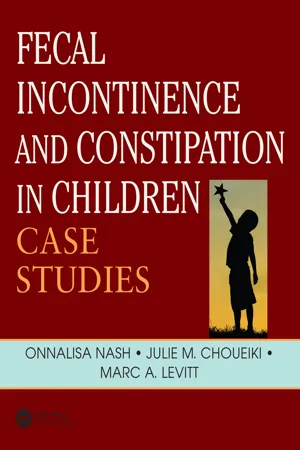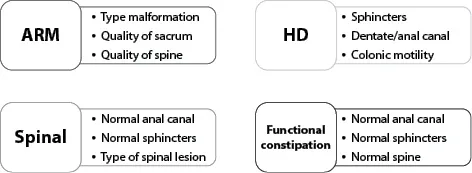
eBook - ePub
Fecal Incontinence and Constipation in Children
Case Studies
- 185 pages
- English
- ePUB (mobile friendly)
- Available on iOS & Android
eBook - ePub
Fecal Incontinence and Constipation in Children
Case Studies
About this book
This book focuses on the management of children with fecal incontinence and constipation. Despite accurate anatomic reconstruction, many children still suffer from a variety of functional bowel problems. These include not only children with congenital anatomic problems such as anorectal malformations and Hirschsprung disease, but also includes the huge population of children who suffer from constipation, with or without soiling, and a large spinal population (spina bifida) who have bowel problems.
Frequently asked questions
Yes, you can cancel anytime from the Subscription tab in your account settings on the Perlego website. Your subscription will stay active until the end of your current billing period. Learn how to cancel your subscription.
No, books cannot be downloaded as external files, such as PDFs, for use outside of Perlego. However, you can download books within the Perlego app for offline reading on mobile or tablet. Learn more here.
Perlego offers two plans: Essential and Complete
- Essential is ideal for learners and professionals who enjoy exploring a wide range of subjects. Access the Essential Library with 800,000+ trusted titles and best-sellers across business, personal growth, and the humanities. Includes unlimited reading time and Standard Read Aloud voice.
- Complete: Perfect for advanced learners and researchers needing full, unrestricted access. Unlock 1.4M+ books across hundreds of subjects, including academic and specialized titles. The Complete Plan also includes advanced features like Premium Read Aloud and Research Assistant.
We are an online textbook subscription service, where you can get access to an entire online library for less than the price of a single book per month. With over 1 million books across 1000+ topics, we’ve got you covered! Learn more here.
Look out for the read-aloud symbol on your next book to see if you can listen to it. The read-aloud tool reads text aloud for you, highlighting the text as it is being read. You can pause it, speed it up and slow it down. Learn more here.
Yes! You can use the Perlego app on both iOS or Android devices to read anytime, anywhere — even offline. Perfect for commutes or when you’re on the go.
Please note we cannot support devices running on iOS 13 and Android 7 or earlier. Learn more about using the app.
Please note we cannot support devices running on iOS 13 and Android 7 or earlier. Learn more about using the app.
Yes, you can access Fecal Incontinence and Constipation in Children by Onnalisa Nash, Julie Choueiki, Marc Levitt, Onnalisa Nash,Julie Choueiki,Marc Levitt,Marc A Levitt in PDF and/or ePUB format, as well as other popular books in Medicine & Gastroenterology & Hepatology. We have over one million books available in our catalogue for you to explore.
Information
I |
| PART Bowel management |
1 | |
| General guidelines for bowel management | |
Stephanie J. Vyrostek |
Bowel management is an outpatient program used to treat fecal incontinence. The clinician selects an appropriate treatment modality, either oral stimulant laxatives or a mechanical program (once daily rectal or antegrade enema). The therapy is adjusted throughout the course of a devoted week according to the patient report and daily abdominal radiograph findings. Whether using an oral stimulant laxative or rectal enema washout, the goal of treatment in both cases is to stimulate a daily bowel movement and empty the colon. The child should then not have another bowel movement or soiling for 24 hours until the next treatment and thereby will be clean and able to wear normal underwear.
The week begins with a contrast enema. This image provides information regarding the shape and size of the colon. Additionally, the speed at which a child evacuates contrast, as seen on subsequent abdominal radiographs, can provide valuable information from which one can infer the colonic motility. The contrast also cleans the colon of residual stool, giving the patient an empty colon to start the week of treatment. If after a contrast enema the patient still has a significant fecal burden, an at home bowel clean out is given prior to starting a mechanical program or laxative trial. The colon must be radiographically clean before starting either program.
Treatment modality: Mechanical program or stimulant laxatives?
The clinician should consider whether the patient has good or poor potential for bowel control when selecting the treatment modality for the bowel management week. Patients with a good potential for bowel control typically respond very well to a stimulant laxative and water-soluble fiber therapies, but may benefit from rectal or antegrade enemas for a period of time depending on if there is dilation of the rectum and rectosigmoid that may impair rectal sensation or if they have never learned to have bowel control. They also become clean quickly and enjoy being clean, which sets them up for success when they try future laxative therapy. Patients with poor potential for bowel control benefit from a mechanical program (rectal or antegrade enema). Each regimen must be tailored to the needs of the patient, with particular attention paid to the age of the child, the underlying diagnosis (e.g., anorectal malformation, Hirschsprung disease, functional constipation, spinal conditions, sacrococcygeal teratoma), and the child’s “potential” for bowel control (i.e., their inherent ability to have voluntary bowel movements).
Potential for bowel control
There are multiple factors that can be used to assess whether a patient has good potential for bowel control. These include maturity and a commitment to potty train, anal anatomy, anal sphincters, normal sacral anatomy, normal spinal anatomy (and thus normal innervation of the anorectum), and an anoplasty (surgically created anus) located in the center of the sphincter mechanism and without stricture or prolapse. We will review these six factors and how each can affect children with an anorectal malformation (ARM), Hirschsprung disease (HD), functional constipation, and spinal processes (see Figure 1.1).

Figure 1.1 Predictors of continence. ARM = anorectal malformation, HD = Hirschsprung disease.
Maturity and commitment to potty training
The age at which children begin potty training is different in a variety of countries and cultures. There are certain parts of the world that require the child to be potty trained to go to organized schooling such as preschool. This leads to...
Table of contents
- Cover
- Half Title
- Title Page
- Copyright Page
- Contents
- Preface
- Contributors
- Acknowledgments
- Part I: Bowel Management
- Part II: Anorectal Malformations
- Part III: Hirschsprung Disease
- Part IV: Spinal Anomalies
- Part V: Functional Constipation
- Part VI: Radiology
- Part VII: Myths
- Part VIII: Medication Protocols
- Index